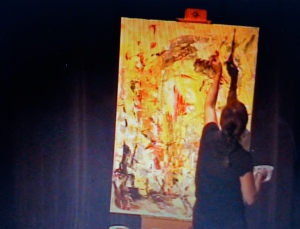Stepping Into the Fear
 Last weekend, our church presented Mosaic: A Night with the Arts, which is an annual event featuring an eclectic blend of artistic expressions—poetry, drama, performance painting, dance, music, short story, art gallery, technical arts. It’s a presentation from the many artists in our local church, so there’s a wide variety of styles and flavors—from classical to jazz, from modern to lyrical dance, from watercolor to oils to quilting. During Mosaic, we give ourselves permission to do the things that might not be applicable to a Sunday morning service, pushing the envelope artistically as well as dealing with adult themes and concepts.
Last weekend, our church presented Mosaic: A Night with the Arts, which is an annual event featuring an eclectic blend of artistic expressions—poetry, drama, performance painting, dance, music, short story, art gallery, technical arts. It’s a presentation from the many artists in our local church, so there’s a wide variety of styles and flavors—from classical to jazz, from modern to lyrical dance, from watercolor to oils to quilting. During Mosaic, we give ourselves permission to do the things that might not be applicable to a Sunday morning service, pushing the envelope artistically as well as dealing with adult themes and concepts.
One of the elements we decided to do this year was a mixed-discipline improvisation. Specifically, I was to spontaneously create a three-movement piece on the piano, and one of our abstract painters, Julie Lueken, was to spontaneously paint what I was playing. Julie and I didn’t collaborate before-hand; we simply talked about what the three movements would be: awakening, conflict, redemption.
The week prior, I talked to Julie and asked her if it would be wise if we practiced some improvisation together. She replied, “We’d better not. I think I just need to step into the fear.” I knew what she meant by that. There is a natural fear that permeates any honest artmaking. Because making good art is very difficult. And making honest art even harder. As artists, we sometimes feel the fear of the struggle—a struggle not only to make good art, but to be at peace with the art we end up making.
Now, my musical piece was less John Mayer and more John Cage. I banged on the piano (with our nine-foot Steinway Model D, there’s a lot of piano to bang), plucked and strummed the strings, played a lot of unusual dissonance. I went from pianissimo to fortissimo and back again. I probably played about eight minutes. And as I banged and stroked and played, Julie was hard at work, floating golden streaks and stabbing crimson dots and stroking chocolate scribbles on the canvas. Awakening. Conflict. Redemption.
It was at once thrilling and frightening.
And at the end, it seemed that we both sensed that we were done, both sensed a peace about our performance. As I sat back from the piano, she wiped her paintbrush and set it down in the jar. The eight minutes of extemporaneous fear gave way to a relaxed Shalom.
I’ve spoken many times before about how art is a dialogue—both horizontally to our audience and to one another, and vertically with God. I can’t truly explain what I was feeling as I sat at the piano, not knowing what my next note would be until the moment I played it. And I don’t think Julie could explain each brushstroke either. But I do trust that the Holy Spirit was present in the creation of this piece, just as the audience sat, present and mesmerized, by our performance.
“So do not fear, for I am with you; do not be dismayed, for I am your God. I will strengthen you and help you; I will uphold you with my righteous right hand.” Isaiah 41:10 NIV




